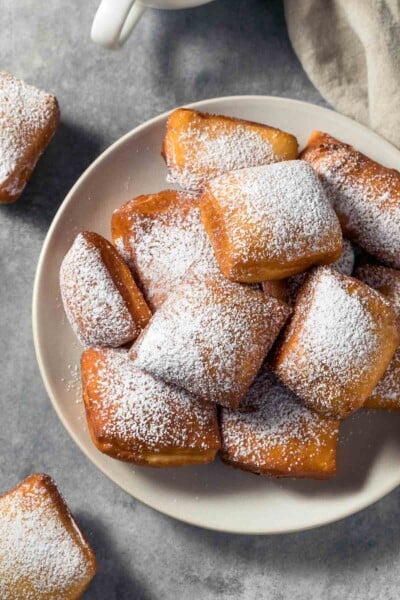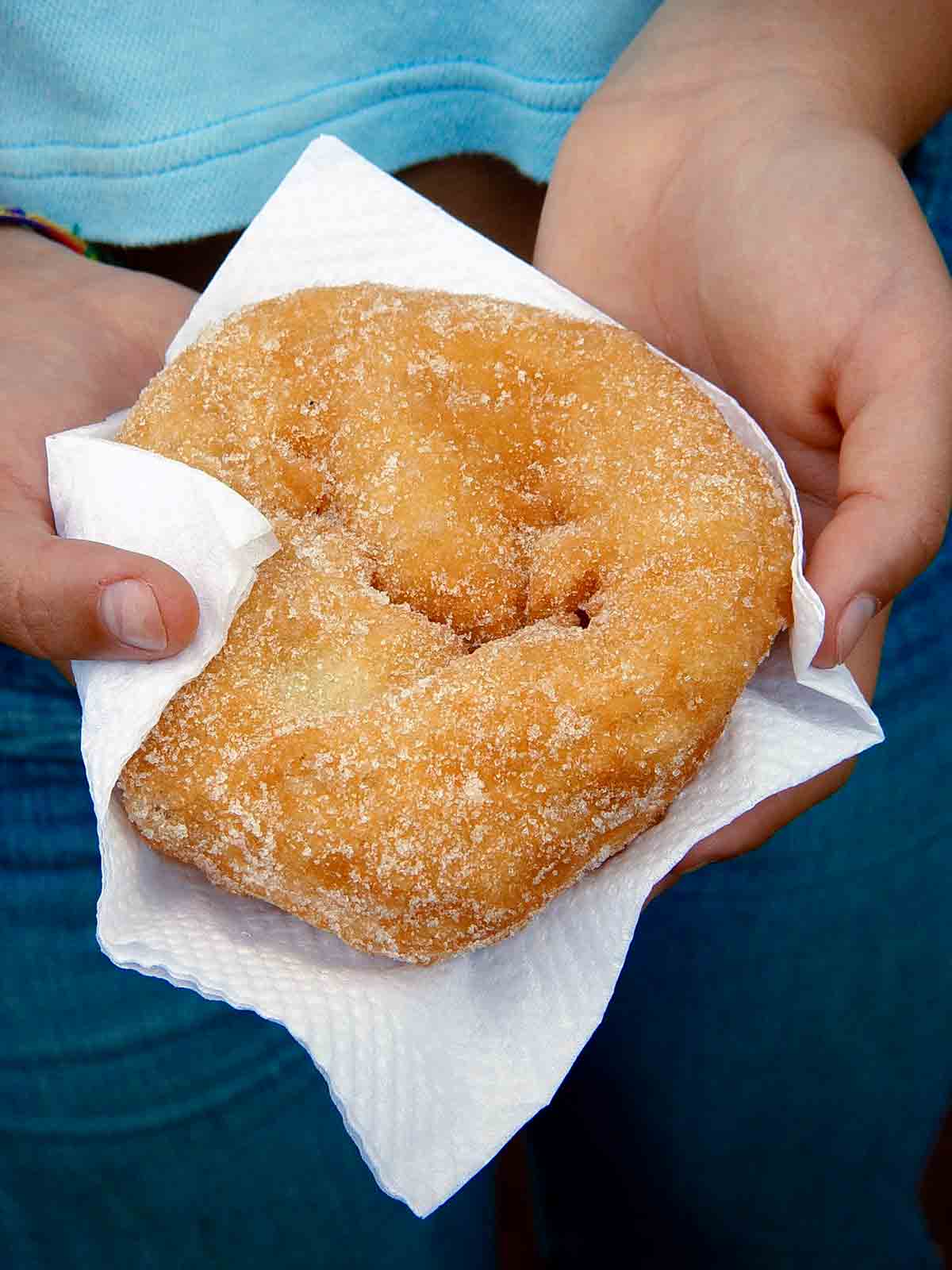
These knee-wobblingly delicious pillows of fried dough that are buried beneath mounds of confectioners’ sugar originally came about as breakfast for dockworkers and merchants at the old French Market in New Orleans, according to author Constance Snow. They’re crisp on the outside and soft inside, sort of like the sopapilla of The Big Easy.
Serve the beignets while still hot. If you’ve been to Cafe du Monde in New Orleans, you know well the warning not to wear black while tucking into a plateful of them. I suggest you heed the same advice when indulging in these treats at home.

Why Our Testers Loved This
Our testers were delighted with these crispy New Orleans-style beignets, particularly when smothered in powdered sugar. They loved that the recipe worked perfectly as written and was “very easy to make.”
Notes on Ingredients
- Sugar–If you prefer a very sweet beignet, add a couple of extra tablespoons of sugar to the dough.
- Oil–Choose an oil for frying that has a high smoke point and neutral flavor. Refined peanut, safflower, or sunflower oils are all good choices.
Step-by-Step Instructions
- Proof the yeast in warm water. Blitz 3 cups of flour, sugar, and salt together in a food processor.
- Heat the milk and butter until the butter melts. Pour the milk mixture into the food processor and whiz until blended.
- Add the remaining ingredients to the food processor. Let the dough rest for at least 10 minutes.
- Preheat the oven to 200°F. Line a platter or baking sheet with paper towels. Heat 3 inches of oil in a saucepan or deep fryer to 360°F.
- Divide the dough in half. Knead each piece of dough briefly, then roll into a 1/4-inch-thick rectangle. Cut each rectangle into 6 pieces.
- Fry the beignets in batches until puffed and golden. Drain on paper towels and keep warm in the oven while frying the remaining dough.
- Serve hot, dusted with confectioners’ sugar.
Common Questions
Serve these crispy fritters hot, with a generous coating of confectioners’ sugar and a hot cup of coffee. They can be served as a breakfast pastry, a dessert, or a snack.
Fried beignets are best served immediately after cooking, but the dough can be prepared up to 1 day ahead and stored in a covered container in the refrigerator. Dough that’s stored overnight will produce a crispier beignet.
Indeed they can. After frying the beignets and letting them cool completely, place them in a single layer on a baking sheet and freeze fully. Transfer them to a freezer-safe container or bag and store them in the freezer for up to 2 months. When you’re in the mood for a treat, simply reheat them in the oven at 350°F for 5 to 10 minutes or until they are warmed through.
Pro Tips
- Plan to serve the beignets immediately after frying. They’re best served hot.
- The dough can be stored in the refrigerator for up to 1 day before frying. Dough that is stored overnight with produce a crispier beignet.
- To avoid greasy or soggy beignets, let your oil return to 360°F between batches.
Write a Review
If you make this recipe, or any dish on LC, consider leaving a review, a star rating, and your best photo in the comments below. I love hearing from you.–David
Want to Save This?

New Orleans-Style Beignets
Ingredients
- 1 package (2 1/2 teaspoons) active dry yeast
- 1/4 cup warm 110°F (43°C) water
- 4 1/2 cups all-purpose flour
- 3 tablespoons granulated sugar, or more to taste
- 3/4 teaspoon fine sea salt
- 1 cup whole milk
- 4 tablespoons (2 oz) unsalted butter
- 1 large egg
- Peanut oil or mild vegetable oil, for deep-frying
- Confectioners’ sugar, for dusting
Instructions
- In a small bowl, sprinkle the yeast over the warm water and let stand until creamy, about 5 minutes.
- In a food processor, combine 3 cups (15 ounces) of the flour, the granulated sugar, and salt. Process briefly.
- In a small saucepan over medium heat, combine the milk and butter and heat gently until the butter melts and the milk is warm but not steaming. Remove from the heat. With the processor running, pour the milk mixture through the feed tube and process until blended.
- Add the egg, yeast mixture, and the remaining 1 1/2 cups (7 1/2 ounces) flour and process just until a soft dough forms. If you prefer a softer beignet, let the dough rest at room temperature for 10 minutes; if you like your beignet a little crisp at the edges, cover and refrigerate the dough until chilled through or up to overnight.
- Preheat the oven to 200°F (95°C). Line an ovenproof platter with paper towels. Pour the oil to a depth of 3 inches in a deep, heavy saucepan or a deep fryer and heat to 360°F (182°C) on a deep-frying thermometer.
- While the oil is heating, divide the dough into 2 equal pieces. On a well-floured work surface, knead 1 piece of the dough briefly until soft but not sticky. Roll into a rectangle about 1/4 inch thick. Cut into 6 equal rectangles (or, if you prefer more modestly sized beignet, 8 or 12 rectangles).
- When the oil is ready, drop 2 or 3 rectangles into the oil and fry, turning once, until puffed and brown, about 2 minutes on each side. Transfer to the paper towels and keep warm in the oven. Repeat with the remaining rectangles, and then the remaining dough.
- Arrange the beignets on a warmed plate and, using a fine-mesh sieve, dust them heavily with confectioners’ sugar or place the confectioners’ sugar in a brown paper bag, add few beignets at a time to a brown paper bag, fold the top of the bag several times to seal, and then gently shake to coat. Serve the beignets at once. (As if you could wait…!)
Notes
- Serving–Plan to serve the beignets immediately after frying. They are best served hot.
- Get ahead–The dough can be stored in the refrigerator for up to 1 day before frying. Dough that is stored overnight with produce a crispier beignet.
- Oil temperature–To avoid greasy or soggy beignets, let your oil return to 360°F between batches.

Nutrition
Nutrition information is automatically calculated, so should only be used as an approximation.
Recipe Testers’ Reviews
This New Orleans-style beignets recipe worked as written and was very easy to make. I would’ve liked a little more sugar in the dough. The recipe that I usually use—and most beignet recipes, call for two eggs and one-half cup of granulated sugar, whereas this recipe called for one egg and three tablespoons of granulated sugar. But I guess sweetness is a matter of taste.
The first night, I fried them right away as the recipe called for. They puffed and were pretty good, but they weren’t as crispy as I prefer. I put the rest of the dough in the fridge overnight. Tonight they were crisper and not as doughy.













I made these today! I cut the recipe in half and cut them in 2 and 3 inch squares and they were amazing. I must have gotten 30 to 40 beignets but it’s hard to count when you’re eating them as soon as they come out 🙂 at least when my SO gets in the kitchen! Note to anyone else who is wondering: you can make the recipe with bread machine/quick rise yeast, the 10 min rise is enough, just add the yeast to your dry ingredients and add the water to your milk mixture.
Also this can be done in a stand mixer with a dough hook!
Magnificent, Gloria! So glad you love these as much as we do! And we so appreciate you taking the time to share your tricks. Greatly appreciate it!
I made these again and let the dough rest overnight and they were delightfully crisp!
Wonderful, Gloria. Sounds we got ourselves an addict!!